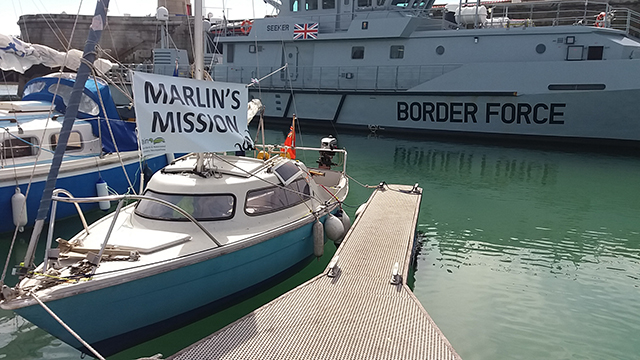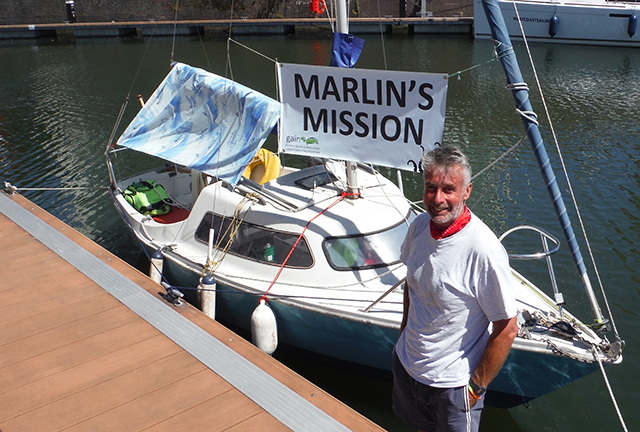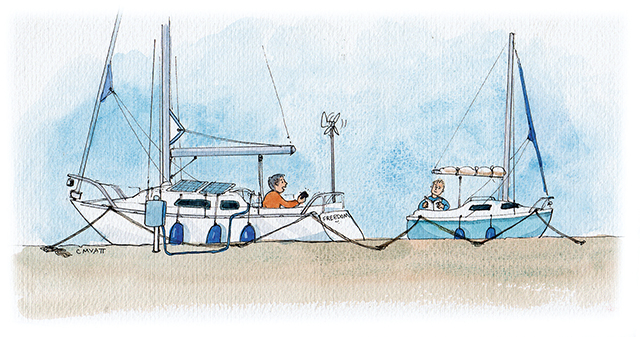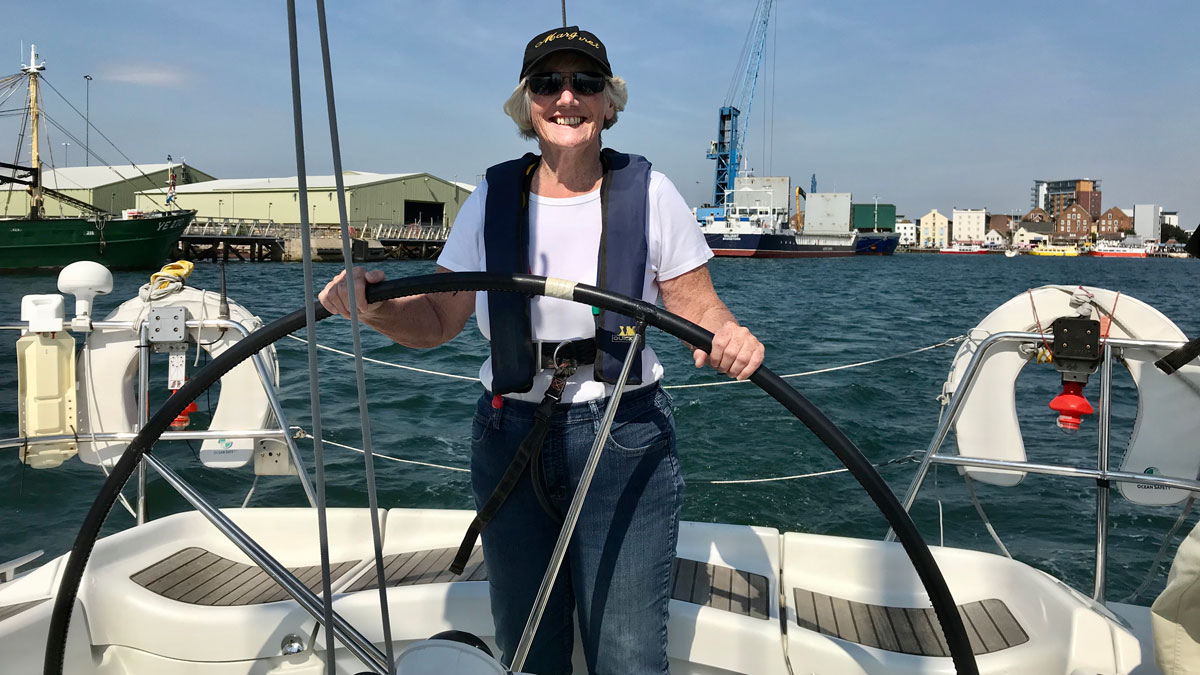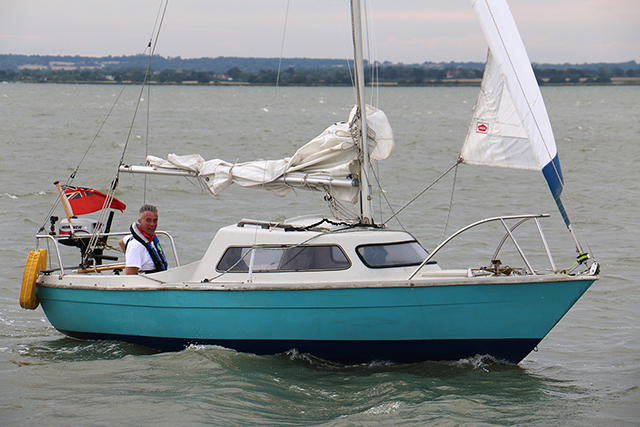Why the art of anchoring is something to be shared, like it or not
Anchors are purely decorative items, and while it’s fine to talk about them in shorebased RYA theory courses they are not really suited to marine applications (much like varnish, Jack Russells and boats).
That’s why marinas exist, and in marinas is where anchors come into their own, as the sight of your jagged battering ram heading for a row of parked boats ensures there’s always someone on hand to take your lines.
Indeed, there are some schools of thought (but not RYA-approved ones) that recommend grinding your anchor to a sharp point and welding it to your bow-roller.
Anchor types have names like Last-Grasp, InSeaQure, Prop-Mangler, D-Angler, The Stress-Full and, of course, the traditional fisherman’s fiend, the Fail-Nail.
And that’s all you really need to know.
However, if you’re some kind of die-hard stress-head who insists on using your anchor in water, here’s the approved best practice, as advised by
organisations like the RYA (but not the RYA) and magazines like PBO (but not PBO): first, unshackle the anchor from its chain; next, chuck the anchor overboard; then tie up to a buoy; and finally… relax.
Of course, there’s some anxiety involved, which is only proper for anything to do with sailing, as there are irresponsible mooring owners around whose buoys have rusty chain no thicker than a charm bracelet with little more than a sentimental attachment to the sea bed. It’s a scandal!
But if you’re really determined to anchor there is another alternative. This was how I eventually discovered the glorious solitude of Pyefleet Creek, one of the most magical spots on the East Coast, where I’d long hankered to watch the sun go down in quiet contemplation with a can of skull-splitter lager.
True, for Zen-like contentment marinas pretty much do it for me, what with all those lovely hot showers, real flushing toilets, and welcoming neon-signed bars and restaurants. Yet something in my soul yearned for even more, to lay just once in Pyefleet under a blanket of stars.
Unfortunately there’s no marina there. One option I’d considered was to run my boat aground and look for nightlife on Mersea Island, but there isn’t any – it’s just full of nature.
When I heard that friends Gerry and Julie were planning a quiet weekend in Pyefleet aboard their beautiful steel yacht with a huge anchor, I seized the opportunity and gave chase.
As I closed in they were just starting to faff with their anchor, so I stood off and circled them for half an hour.
For an eternity they gazed around intently looking for transits, but it seems there aren’t any on the Mersea foreshore, unlike Jaywick where the shore is littered with them and other burnt-out vehicles.
By then I was finding it all quite stressful, but when their kettle whistled, which I took as a sign of welcome, I closed in again, only for them to lift anchor and motor off at high speed; just goes to show how difficult anchoring is!
I could barely keep up as my mighty 3.3hp Mariner rattled deafeningly at full. It was so loud I could only just hear the squawks of five thousand birds as they lifted from the marshes to migrate – three months early. Ain’t nature wonderful, I thought. A bit mysterious too. And noisy.
Gerry and Julie’s next attempt was equally stressful – I was running low on fuel by now – but they’d picked an even lovelier spot with nothing around, just nature. As soon as I saw them hoist a big black ball, which I recognised from classes run by organisations like the RYA (but not the RYA) as a sign for welcome, I chucked my fenders out and hopped aboard.
They were so transfixed by the wonder of the place they barely spoke, and even then only in hushed reverent whispers. Ever eager to learn I asked what was wrong with their first anchorage: “Nothing,” they whispered – quite loudly – in unison. It seems anchoring is baffling, even to people who do it.
Dinner was vegetarian, which I found a bit lacking in meat, and washed down with red wine, which was OK but it wasn’t lager, and while the shower was pretty warm, I would have preferred a little more water pressure.
As I cast off in the morning, after a breakfast of grainy stuff which I found a little lacking in bacon, eggs, black pudding, chips and beans, I realised what I’d been missing all these years.
Anchoring, if done in a prudent, seamanlike fashion, as taught by organisations like the RYA (but not the RYA) can be almost as good as marinas.
I just didn’t realise you have to be vegetarian. That’s something you don’t learn on courses.
Anchoring a boat: 6 tips to keep you safe
If space is tight or the weather looks unsettled, it’s worth having a few skills up your sleeve to make…
Nav in a nutshell: Looks good on paper
Up-to-date printed paper charts are a good bet for identifying your position – but they do have their limits, says…
How not to cause a scene when anchoring
Avoid a blazing row with hand signals
DIY Doctor Dave – Dave Selby’s Mad about the Boat
Emboldened by the lack of response to his first PBO practical article, Dave pledges to reveal how to remove your…
Anchoring is allowed in Osborne Bay
RYA: Beach's swimming area does not affect sailors
Dave Selby sets sail on Marlin’s Mission
Dave Selby sets sail on his 18ft Sailfish Marlin on a 300-mile voyage to the Southampton Boat show to promote…
Dave Selby Blog 6: Setting sail from Dover
I hope you’ll join me for the next leg of Marlin’s Mission, either in your boats or aboard Marlin, says…
Sailfish challenger Dave Selby reaches London on his ‘last legs’
PBO's Dave Selby, who is battling a rare nerve illness, won a tense race against time to sail his 18ft…
Ohm improvements – Dave Selby’s Mad about the Boat
Formerly ohmless and happy, ‘analogue Dave’ is now going digital
Becoming a Day Skipper
From classroom conundrums to night-time navigation, dinghy instructor Margaret Norris decides to give big boats a go
Handling rough conditions in port
Rupert Holmes describes the course of action he pursued – and the lessons learned – when storm conditions threatened to…
Dave Selby Blog 5: Back home again – but not for long!
Dave Selby's 300-mile voyage in a Sailfish 18 has begun but some 'mucky weather' is hampering progress...
Blog 2: Dave Selby flees to Sardinia
I’m so daunted by the enormity of Marlin’s Mission I’ve fled to Sardinia to spend a week with friends on…
Dave Selby’s 300-mile voyage in a Sailfish
Dave is calling for PBO readers to join in with his sailing adventure, to share their wisdom, cheer him along…











